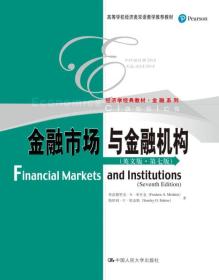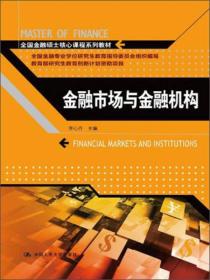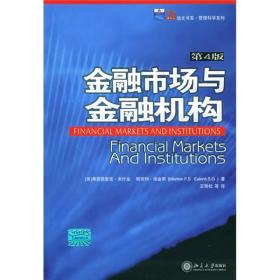
金融市场与金融机构(英文版·第七版)(高等学校经济类双语教学推荐教材;经济学经典教材·金融系列)
¥ 28.8 3.7折 ¥ 78 全新
库存2件
河北保定
认证卖家担保交易快速发货售后保障
作者弗雷德里克·S·米什金、斯坦利·G·埃金斯 著
出版社中国人民大学出版社
出版时间2016-07
版次1
装帧平装
货号9787300229324
上书时间2024-11-28
- 在售商品 暂无
- 平均发货时间 27小时
- 好评率 暂无
- 最新上架
商品详情
- 品相描述:全新
图书标准信息
- 作者 弗雷德里克·S·米什金、斯坦利·G·埃金斯 著
- 出版社 中国人民大学出版社
- 出版时间 2016-07
- 版次 1
- ISBN 9787300229324
- 定价 78.00元
- 装帧 平装
- 开本 16开
- 纸张 胶版纸
- 页数 608页
- 字数 99999千字
- 丛书 高等学校经济类双语教学推荐教材·经济学经典教材·金融系列;
- 【内容简介】
- 本书是英文影印版本,是美国多所著名大学商学院共同选用的系统介绍金融市场与金融机构运作机制的畅销著作,也是一本实用的工具手册。本书通过建立一个研究金融市场与金融机构的统一分析框架,引导学生依据一些基本的经济与金融理论(包括信息不对称、利益冲突、交易成本、供求关系、资本市场均衡、有效市场以及风险的衡量与管理等)来理解资产定价、金融市场结构以及金融机构管理等方面的金融理论。与此同时,本书通过大量的真实案例,巧妙地将理论与现实应用结合起来。
- 【作者简介】
-
弗雷德里克•S•米什金,1976年于美国麻省理工学院获经济学博士学位。曾先后执教于美国的芝加哥大学、西北大学、普林斯顿大学和哥伦比亚大学。1994—1997年,曾任纽约联邦储备银行研究部执行副主席兼主任,美联储公开市场委员会经济学家。现为哥伦比亚大学商学院教授,同时兼任美国国民经济研究局研究员,FDIC中心银行高级研究员,东部经济协会主席,中国人民大学荣誉教授,世界银行、国际货币基金组织和许多国家中央银行的顾问。其主要研究领域为货币政策、金融市场和宏观经济学,迄今已出版《货币、利率和通货膨胀》(Money,Interest Rates and Inflation)、《货币金融学》(The Economics of Money, Banking and Financial Markets)等十余部专著与教材,并在专业期刊中发表了100余篇学术论文。
斯坦利•G•埃金斯,东卡罗来纳大学商学院副院长,具有丰富的金融从业经验,曾是费尔班克斯**国民银行的副总裁和审计长,也是商业和房地产信贷主任,还是知名保险公司DenaliTitie and EscrowAgericy的创始人。他曾在很多学术杂志上发表文章,如《商业和经济学季刊》、《金融研究杂志》、《国际金融分析评论》。
- 【目录】
-
第一部分 概 览
第1章 为什么要研究金融市场和金融机构? 1
1.1 为什么要研究金融市场?2
1.2 为什么要研究金融机构?5
1.3 应用管理视角 7
1.4 如何研究金融市场和金融机构?8
1.5 网络练习 9
1.6 总结 11
第2章 金融体系总览 14
2.1 金融市场的功能 15
2.2 金融市场的结构 16
2.3 金融市场的国际化 18
2.4 金融中介机构的职能:间接融资 20
2.5 金融中介的类型 25
2.6 金融监管体系 28
第二部分 金融市场基础
第3章 利率的含义及其在定价中的作用 33
3.1 利率的计算 34
3.2 实际利率与名义利率的区别 44
3.3 利率与收益率的区别 46
第4章 利率的变化 59
4.1 资产需求的决定因素 59
4.2 债券市场的供给和需求 63
4.3 均衡利率的变动 66
第5章 风险和期限结构对利率的影响 81
5.1 利率的风险结构 81
5.2 利率的期限结构 88
第6章 金融市场效率 106
6.1 有效市场假说 107
6.2 有效市场假说的实证 110
6.3 行为金融学 119
第三部分 金融机构基础
第7章 金融机构的存在 122
7.1 世界各国金融机构的基本情况 122
7.2 交易成本 125
7.3 信息不对称:逆向选择和道德风险 127
7.4 次品车问题:逆向选择如何影响金融结构?127
7.5 道德风险如何影响债务合约和股权合约的选择?132
7.6 道德风险如何影响债务市场中的金融结构?135
7.7 利益冲突 141
第8章 金融危机的产生及其危害 149
8.1 信息不对称与金融危机 150
8.2 发达经济体金融危机的动态过程 150
8.3 新兴市场经济体金融危机的动态过程 162
第四部分 中央银行和货币政策的实施
第9章 中央银行和联邦储备体系 173
9.1 联邦储备体系的起源 174
9.2 联邦储备体系的正式结构 174
9.3 联邦储备体系有多大的独立性? 177
9.4 欧洲中央银行的结构和独立性 179
9.5 其他国外中央银行的结构和独立性 183
9.6 对中央银行行为的解释 189
9.7 联邦储备体系是否应该独立?189
第10章 货币政策实施:工具、目标、战略和策略 194
10.1 联邦储备体系的资产负债表 194
10.2 准备金市场和联邦基金利率 197
10.3 货币政策工具 203
10.4 贴现政策 205
10.5 法定存款准备金要求 207
10.6 欧洲中央银行的货币政策工具 209
10.7 价格稳定目标和名义锚 210
10.8 其他货币政策目标 212
10.9 价格稳定是否应该成为货币政策的首要目标?213
10.10 通货膨胀目标215
10.11 中央银行应对资产价格泡沫:从2007—2009年金融危机中吸取的教训 219
10.12 策略:政策工具的选择 223
第五部分 金融市场
第11章 货币市场230
11.1 货币市场的界定 231
11.2 货币市场的目的 233
11.3 货币市场的参与者 234
11.4 货币市场工具 236
11.5 货币市场工具的比较 247
第12章 债券市场252
12.1 资本市场的作用 252
12.2 资本市场的参与者 253
12.3 资本市场交易 253
12.4 债券的种类 254
12.5 国债 254
12.6 市政债券 258
12.7 公司债券 260
12.8 债券的财务担保 265
12.9 债券收益率的计算 265
12.10 附息债券的价值 267
12.11 债券投资 269
第13章 股票市场273
13.1 投资股票 273
13.2 普通股定价 278
13.3 市场如何决定证券价格? 281
13.4 估值误差 283
13.5 股票市场指数 285
13.6 购买外国股票 286
13.7 股票市场的监管 288
第14章 抵押贷款市场 292
14.1 什么是抵押贷款? 293
14.2 住房抵押贷款的特点 294
14.3 抵押贷款的类型 298
14.4 抵押贷款机构 301
14.5 抵押贷款服务 302
14.6 抵押贷款二级市场 303
14.7 抵押贷款证券化 304
第15章 外汇市场311
15.1 外汇市场 312
15.2 长期汇率 315
15.3 短期汇率:供求分析 318
15.4 汇率变动的解释 321
第15章附录 利率平价条件334
A15.1 国内外资产预期收益率的对比 334
A15.2 利率平价条件 336
第16章 国际金融体系 338
16.1 外汇市场干预 338
16.2 国际收支平衡表 342
16.3 国际金融体系中的汇率制度 344
16.4 资本管制 353
16.5 国际货币基金组织的作用 354
第六部分 金融产业
第17章 银行和金融机构管理 360
17.1 银行的资产负债表 361
17.2 银行的基本业务 364
17.3 银行管理的一般原则 366
17.4 资产负债表外业务 374
17.5 银行绩效的衡量 377
第18章 金融监管384
18.1 信息不对称和金融监管 384
18.2 20世纪80年代的存贷款业务和银行危机 400
18.3 1991年《联邦存款保险公司改进法》 401
18.4 世界范围内的银行危机 402
18.5 《多德-弗兰克法案》与未来监管 404
第19章 银行业:结构和竞争 409
19.1 银行体系的发展历史 409
19.2 金融创新和影子银行体系的成长 412
19.3 美国商业银行业的结构 426
19.4 银行合并和全国性银行 428
19.5 银行业的拆分和其他金融服务业 432
19.6 互助储蓄业:监管和结构 433
19.7 跨国银行业务 435
第20章 共同基金440
20.1 共同基金的发展 440
20.2 共同基金的结构 442
20.3 按投资标的物分类 446
20.4 投资基金的费用结构 451
20.5 共同基金的监管 452
20.6 对冲基金 453
20.7 共同基金的利益冲突 456
第21章 保险公司和养老金462
21.1 保险公司 463
21.2 保险的基本原则 463
21.3 保险公司的发展和组织形式 466
21.4 保险的种类 466
21.5 养老金 478
21.6 养老金的类型 479
21.7 养老金计划的监管 484
21.8 养老金展望 487
第22章 投资银行、证券经纪商、经销商和风险投资公司 489
22.1 投资银行 490
22.2 证券经纪人和经销商 497
22.3 证券公司的监管 501
22.4 证券公司与商业银行的关系 502
22.5 私募股权投资 502
22.6 私募股权收购 506
第七部分 金融机构管理
第23章 金融机构的风险管理 511
23.1 信用风险管理 512
23.2 利率风险管理 515
第24章 利用金融衍生工具套期保值 530
24.1 套期保值 530
24.2 远期市场 531
24.3 金融期货市场 532
24.4 股指期货 541
24.5 期权 544
24.6 利率互换 550
24.7 信用衍生工具 553
术语表G-1
英文目录:
Preface
About the Authors
PART ONE INTRODUCTION 1
Chapter 1 Why Study Financial Markets and Institutions? 1
Why Study Financial Markets? 2
Why Study Financial Institutions? 5
Applied Managerial Perspective 7
How We Will Study Financial Markets and Institutions 8
Web Exercise 9
Concluding Remarks 11
Chapter 2 Overview of the Financial System 14
Function of Financial Markets 15
Structure of Financial Markets 16
Internationalization of Financial Markets 18
Function of Financial Intermediaries: Indirect Finance 20
Types of Financial Intermediaries 25
Regulation of the Financial System 28
PART TWO FUNDAMENTALS OF FINANCIAL MARKETS
Chapter 3 What Do Interest Rates Mean and What Is Their Role in
Valuation? 33
Measuring Interest Rates 34
The Distinction Between Real and Nominal Interest Rates 44
The Distinction Between Interest Rates and Returns 46
Chapter 4 Why Do Interest Rates Change? 59
Determinants of Asset Demand 59
Supply and Demand in the Bond Market 63
Changes in Equilibrium Interest Rates 66
Chapter 5 How Do Risk and Term Structure Affect Interest Rates? 81
Risk Structure of Interest Rates 81
Term Structure of Interest Rates 88
Chapter 6 Are Financial Markets Efficient? 106
The Efficient Market Hypothesis 107
Evidence on the Efficient Market Hypothesis 110
Overview of the Evidence on the Efficient Market Hypothesis
Behavioral Finance 119
PART THREE FUNDAMENTALS OF FINANCIAL INSTITUTIONS 122
Chapter 7 Why Do Financial Institutions Exist? 122
Basic Facts About Financial Structure Throughout the World 122
Transaction Costs 125
Asymmetric Information: Adverse Selection and Moral Hazard 127
The Lemons Problem: How Adverse Selection Influences Financial Structure 127
How Moral Hazard Affects the Choice Between Debt and Equity Contracts 132
How Moral Hazard Influences Financial Structure in Debt Markets 135
Conflicts of Interest 141
Chapter 8 Why Do Financial Crises Occur and Why Are They So
Damaging to the Economy? 149
Asymmetric Information and Financial Crises 150
Dynamics of Financial Crises in Advanced Economies 150
Dynamics of Financial Crises in Emerging Market Economies 162
PART FOUR CENTRAL BANKING AND THE CONDUCT OF
MONETARY POLICY 173
Chapter 9 Central Banks: A Global Perspective 173
Origins of the Federal Reserve System 174
Structure of the Federal Reserve System 174
How Independent Is the Fed? 177
Structure and Independence of the European Central Bank 179
Central Banks Around the World 183
Explaining Central Bank Behavior 189
Should the Central Banks Be Independent? 189
Chapter 10 Conduct of Monetary Policy: Tools, Goals, Strategy,
and Tactics 194
The Federal Reserve’s Balance Sheet 194
The Market for Reserves and the Federal Funds Rate 197
Tools of Monetary Policy 203
Discount Policy 205
Reserve Requirements 207
Monetary Policy Tools of the European Central Bank 209
The Price Stability Goal and the Nominal Anchor 210
Other Goals of Monetary Policy 212
Should Price Stability Be the Primary Goal of Monetary Policy? 213
Inflation Targeting 215
Central Banks’ Response to Asset-Price Bubbles: Lessons from
the 2007–2009 Financial Crisis 219
Tactics: Choosing the Policy Instrument 223
PART FIVE FINANCIAL MARKETS 230
Chapter 11 The Money Markets 230
The Money Markets Defined 231
The Purpose of the Money Markets 233
Who Participates in the Money Markets? 234
Money Market Instruments 236
Comparing Money Market Securities 247
Chapter 12 The Bond Market 252
Purpose of the Capital Market 252
Capital Market Participants 253
Capital Market Trading 253
Types of Bonds 254
Treasury Notes and Bonds 254
Municipal Bonds 258
Corporate Bonds 260
Financial Guarantees for Bonds 265
Current Yield Calculation 265
Finding the Value of Coupon Bonds 267
Investing in Bonds 269
Chapter 13 The Stock Market 273
Investing in Stocks 273
Computing the Price of Common Stock 278
How the Market Sets Security Prices 281
Errors in Valuation 283
Stock Market Indexes 285
Buying Foreign Stocks 286
Regulation of the Stock Market 288
Chapter 14 The Mortgage Markets 292
What Are Mortgages? 293
Characteristics of the Residential Mortgage 294
Types of Mortgage Loans 298
Mortgage-Lending Institutions 301
Loan Servicing 302
Secondary Mortgage Market 303
Securitization of Mortgages 304
Chapter 15 The Foreign Exchange Market 311
Foreign Exchange Market 312
Exchange Rates in the Long Run 315
Exchange Rates in the Short Run: A Supply and Demand Analysis 318
Explaining Changes in Exchange Rates 321
Chapter 15 Appendix The Interest Parity Condition 334
Comparing Expected Returns on Domestic and Foreign Assets 334
Interest Parity Condition 336
Chapter 16 The International Financial System 338
Intervention in the Foreign Exchange Market 338
Balance of Payments 342
Exchange Rate Regimes in the International Financial System 344
Capital Controls 353
The Role of the IMF 354
PART SIX THE FINANCIAL INSTITUTIONS INDUSTRY
Chapter 17 Banking and the Management of Financial Institutions 360
The Bank Balance Sheet 361
Basic Banking 364
General Principles of Bank Management 366
Off-Balance-Sheet Activities 374
Measuring Bank Performance 377
Chapter 18 Financial Regulation 384
Asymmetric Information and Financial Regulation 384
The 1980s Savings and Loan and Banking Crisis 400
Federal Deposit Insurance Corporation Improvement Act of 1991 401
Banking Crises Throughout the World in Recent Years 402
The Dodd-Frank Bill and Future Regulation 404
Chapter 19 Banking Industry: Structure and Competition 409
Historical Development of the Banking System 409
Financial Innovation and the Growth of the Shadow Banking System 412
Structure of the US Commercial Banking Industry 426
Bank Consolidation and Nationwide Banking 428
Separation of the Banking and Other Financial Service Industries 432
Thrift Industry: Regulation and Structure 433
International Banking 435
Chapter 20 The Mutual Fund Industry 440
The Growth of Mutual Funds 440
Mutual Fund Structure 442
Investment Objective Classes 446
Fee Structure of Investment Funds 451
Regulation of Mutual Funds 452
Hedge Funds 453
Conflicts of Interest in the Mutual Fund Industry 456
Chapter 21 Insurance Companies and Pension Funds 462
Insurance Companies 463
Fundamentals of Insurance 463
Growth and Organization of Insurance Companies 466
Types of Insurance 466
Pensions 478
Types of Pensions 479
Regulation of Pension Plans 484
The Future of Pension Funds 487
Chapter 22 Investment Banks, Security Brokers and Dealers,
and Venture Capital Firms 489
Investment Banks 490
Securities Brokers and Dealers 497
Regulation of Securities Firms 501
Relationship Between Securities Firms and Commercial Banks 502
Private Equity Investment 502
Private Equity Buyouts 506
PART SEVEN THE MANAGEMENT OF FINANCIAL INSTITUTIONS 511
Chapter 23 Risk Management in Financial Institutions 511
Managing Credit Risk 512
Managing Interest-Rate Risk 515
Chapter 24 Hedging with Financial Derivatives 530
Hedging 530
Forward Markets 531
Financial Futures Markets 532
Stock Index Futures 541
Options 544
Interest-Rate Swaps 550
Credit Derivatives 553
Glossary G-1
点击展开
点击收起
相关推荐
— 没有更多了 —






















以下为对购买帮助不大的评价